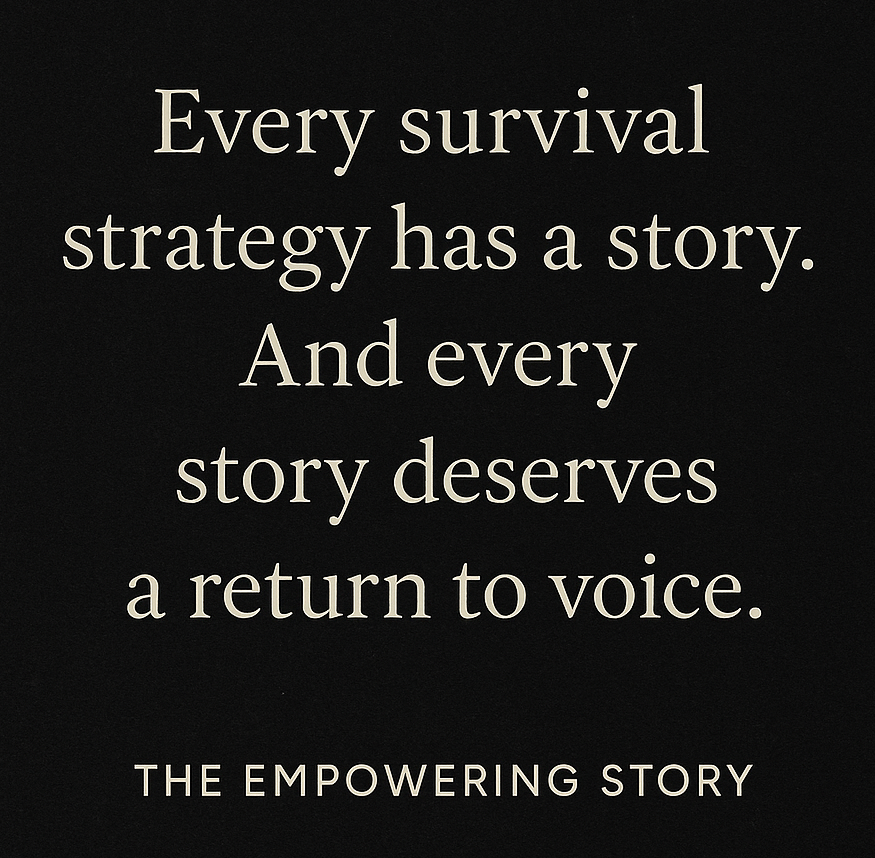The Silent Intelligence of Trauma Adaptation

I once thought my silence was a weakness.
For years, I interpreted emotional withdrawal as avoidance. I saw perfectionism as overcompensation. I treated self-containment as a problem to solve.
But sitting with survivors changed everything.
It wasn't a single moment, but a quiet realization that unfolded over time. These weren't dysfunctions. They were precise adaptations. They weren't shaped by brokenness but by necessity.
I began to see how people had developed an almost surgical ability to sense threats, manage perception, and contain emotion. Not to manipulate others, but to protect something fragile inside.
Their silence wasn't a weakness. It was design.
The Neurobiology of Protection
When the brain perceives an emotional threat, it prioritizes survival overexpression. This isn't something we decide. It's something the nervous system initiates before we're even aware.
At the center is the amygdala, the brain's early-warning system. When it detects danger, it signals the release of stress hormones like cortisol and adrenaline.
These chemicals prepare the body for action: to fight, flee, or freeze. But in cases of chronic emotional danger, especially where a child cannot flee, another adaptation emerges: fawning or internal containment.
Research confirms that "trauma responses are not voluntary choices – they're reflexive, hard-wired responses that all humans exhibit." https://www.nicabm.com/experts/stephen-porges/
Over time, the brain begins to favor circuits that suppress expression, especially if expression once led to punishment or abandonment.
The result is learned silence.
Not as a flaw. But as a high-functioning strategy to remain acceptable, invisible, or emotionally safe.
Smiling becomes a reflex. Speech becomes rehearsed. Emotions are edited in real-time.
And because these neural pathways are repeated, the brain reinforces them like grooves in a record. That's neuroplasticity at work.
Perfectionism: Not Vanity, But Vigilance
Perfectionism doesn’t announce itself as fear. It arrives as mastery—and stays as protection. Perfectionism often gets mischaracterized as ego-driven or controlling. But in the context of trauma, it's rarely about ego.
It's about earning safety in an unpredictable environment.
For many survivors, perfectionism forms early and forms fast. It becomes a survival code. The child discovers, often without language, that being perfect might reduce harm.
If she performs well enough, stays quiet enough, doesn't cause disruption, and doesn't take up space, maybe she won't be targeted. Maybe she'll be seen, loved, or at least left alone.
This perfectionism isn't vanity. It's vigilance.
Studies show that "emotional distancing may have helped them endure relational traumas by impeding the intimacy that can allow someone to come close enough to inflict more relational pain." https://www.frontiersin.org/journals/psychology/articles/10.3389/fpsyg.2021.619018/full
Neurobiologically, perfectionism activates the executive function networks. But it's powered underneath by a threat-sensitive system trying to reduce chaos.
Every move becomes premeditated. Every sentence is weighed. Every flaw is magnified internally before it can be discovered externally.
Why? Because unpredictability equals risk. Perfectionism is a way to reduce exposure.
The deeper truth? Perfectionism is a grief pattern.
It's often rooted in the unspoken belief: "If I had just done everything right, maybe they wouldn't have hurt me."
The Misinterpretation of Survival
The most heartbreaking part of trauma isn't always what happened.
It's how the world misunderstood the adaptations that followed.
Emotional withdrawal is labeled as avoidance, detachment, or coldness. Survivors are called distant, uncooperative, and even "disconnected from their feelings."
But what I see, again and again, is not detachment but overwhelm. Not apathy but a finely tuned emotional filtration system that's learned to protect against further harm.
Withdrawal is not rejection.
It's a nervous system trying to stay inside its window of tolerance, especially in relational spaces that feel volatile or unsafe.
Self-containment is often misread as self-sufficiency. But it's not strength. It's a strategy learned from a world where vulnerability was met with danger, not care.
Professionals may say, "She's high-functioning."
But inside, that same woman may be carrying hypervigilance, exhaustion, and shame. She's succeeding, yes, but in the same way, someone treads water for hours to keep from drowning.
Survival is not the same as thriving.
Even survivors themselves misinterpret their patterns.
They ask: "Why do I sabotage relationships?" "Why can't I just let people in?" "Why am I so emotionally cold?"
And beneath all those questions is usually one unspoken belief: "Something is wrong with me."
But what if nothing's wrong?
What if these patterns made sense?
What if they're not symptoms of damage but signs of intelligence?
My Own Recognition
I, too, once lived in a body that was praised for composure but built for containment. I performed well, I led well, and I presented well.
But underneath that admiration was a constant tension. A need to manage everything. A voice that said, "Don't show too much. Don't need too much. Don't let anyone know how fragile this all feels."
It wasn't false confidence. It was precision containment.
What I later realized is that I had turned perfection into protection.
There was one evening when someone I trusted said something simple: "You always seem so calm. Do you ever get overwhelmed?"
I laughed politely, and gave a polished answer. But something shifted inside.
It was the first time I realized I had built my identity on emotional choreography. That every movement, every pause, every smile, every decision was designed not just for success, but for safety.
That recognition didn't unravel me. It softened me.
I stopped pathologizing my patterns. I stopped calling them dysfunctions.
I started seeing them as brilliant designs from a time when I didn't know another way.
Creating Space for New Possibilities
It begins not with effort, but with witnessing.
Not with trying to be different, but with truly seeing how brilliant we already were just to survive.
Most survivors want change but unconsciously fear what it will cost. Because every adaptation has a deep emotional logic. It once kept us safe.
When we try to remove these adaptations without honoring the purpose they served, we retraumatize the very part of us we're trying to liberate.
So the process begins by thanking the adaptation.
Not as a metaphor, but literally. I've said it out loud: "Thank you, perfection. You helped me not get hurt again." "Thank you, silence. You kept me hidden when hiding was safety."
Then slowly, we begin to ask a question we might never have asked before: "What else might be possible now?"
We don't rush to answer it. We live with it.
And in that space of inquiry, something shifts.
We start to notice when the pattern arises, not to stop it, but to stay present with it. We get curious. We breathe. We pause.
That's when other ways of being begin to arrive.
We risk softness. We experiment with voice. We let ourselves cry in places we used to only perform.
We speak, even if our voice shakes because something inside has decided it's time to return.
None of this happens in a straight line. It's layered. Nonlinear. Tender.
And the key is this: We don't replace our survival strategies.
We expand the self around them until they are no longer the only way we know how to live.
That is what freedom feels like.
Not an escape from what we were. But a return to what we never got to be.
Transforming Our Approach to Healing
Understanding the brain is important. But understanding how it shapes belonging—that’s where healing lives.
When we truly recognize that these patterns are not dysfunctions but brilliant adaptations, we stop trying to fix survivors.
We stop pathologizing survival.
And healing shifts from a process of correction to a process of integration.
Understanding the neurobiology of trauma "helps break down common misconceptions and victim-blaming... and helps survivors to understand their experience and the aftermath in a new way." https://www.unco.edu/assault-survivors-advocacy-program/learn_more/neurobiology_of_trauma.aspx
This doesn't mean we abandon structure or therapeutic insight. It means we orient everything around safety, dignity, and curiosity.
We no longer ask, "How do we get this person to open up?" We ask, "What kind of space would make that even feel like an option?"
It changes the practitioner's role.
We are no longer problem-solvers. We become witnesses and co-regulators.
Not guides who hold the answers, but stewards who hold the space.
The goal is not to dismantle defenses but to understand their origin.
The invitation is not to speak but to feel seen enough that speaking becomes possible.
The emphasis is not on catharsis but on coherence.
The Power of Recognition
When survivors first encounter this perspective, what happens isn't always visible.
There's no applause. No fireworks. No dramatic "aha."
What I often see first is a pause.
Not a confused one, but a deep, internal reorientation. A kind of stillness that's rarely granted to people who've spent years being misunderstood.
And then, sometimes, the tears come.
Not from sadness, but from recognition.
Because for many survivors, this is the first time someone looked at their patterns and didn't ask them to explain, defend, or correct themselves.
Instead, they hear something like: "You weren't weak. You were wise." "You didn't overreact. You adapted." "You did what it took to stay here."
And that moment becomes a return.
A return to dignity. A return to a self that was never broken only rearranged. A return to a body that wasn't betraying them, but carrying the story in a way only it could.
When this recognition lands, survivors often stop fighting themselves.
The inner war, the judgment, the shame, and the exhaustion, soften.
Because they realize that what they once called "too much" or "too cold" or "too sensitive" was just enough to survive what they went through.
And that's the beginning of something real.
Not healing in the polished, marketable sense. But healing as homecoming.
From Self-Judgment to Self-Compassion
Self-judgment isn't just an opinion people hold. It's a survival lens.
It often formed long before language, and it kept them emotionally afloat in a world that didn't make space for their truth.
If someone grows up in an environment where emotional needs are ignored or punished, they often internalize the message: "If I'm hurting, it must be my fault."
And that belief becomes a scaffolding, something to cling to when everything else feels unstable.
So I don't start by trying to change the belief.
I start by creating a space where judgment doesn't feel necessary.
We slow everything down. We explore the story behind the pattern, gently, without pushing.
We speak in terms of protection, not pathology. We name the intelligence in what once felt like a failure.
And then, at some point, I might ask a simple question: "If this part of you didn't think you were broken, what would it say instead?"
It's never about convincing someone they're okay.
It's about offering enough co-regulated space that a different voice, the one underneath the judgment, has a chance to speak.
And when it does, it's almost always gentle. Tentative. Grief-soaked.
Sometimes they say, "I was doing the best I could." Or, "I was just trying to stay safe."
That's the moment where compassion begins.
Not as a strategy, but as an emergence.
And from there, self-compassion becomes less of a practice and more of a remembering.
A remembering that no one survives by accident.
And that everything we've called a flaw was, at some point, a form of brilliance.
A Different Kind of Freedom
So what would I say to someone who recognizes these adaptive patterns in themselves but feels stuck in them?
I would say: Of course, you feel stuck.
Because you've spent years, maybe decades, doing what it took to stay safe.
And now your mind is beginning to open doors your body still isn't sure it wants to walk through.
That's not failure. That's pacing.
That's your nervous system asking: Is it safe now? Can we do it differently?
So the work now isn't to push through.
It's to stay with yourself long enough for trust to catch up to insight.
This in-between space, where you know something's no longer serving you, but you can't quite put it down, that's not a dead zone. It's sacred. It's the threshold.
And the threshold isn't where you sprint. It's where you listen.
You listen for the part of you that's still afraid, and you let it know: "I won't abandon you just to become someone better. We're going forward together."
If that means you speak one word less guarded today than yesterday, that's movement.
If that means you breathe through one reaction instead of disappearing, that's emergence.
If that means you feel the old pattern rise and say "I see you" instead of "What's wrong with me?" that transformation is already in motion.
There's no timeline for this.
There's only the quiet bravery of staying with yourself when it would be easier to self-abandon.
Healing is not linear. It spirals inward—toward the self we once left behind.
So if you feel stuck, I invite you to shift the question.
Instead of asking, "Why am I still like this?", ask: "What is this part of me still trying to protect?" And "Can I honor that without letting it lead?"
That's how new possibilities begin.
Not by force. But by relationship.
With yourself.
Because every survival strategy has a story.
And every story deserves a return to voice.
Every survival strategy has a story. And every story deserves not just a voice—but a place to be heard.

